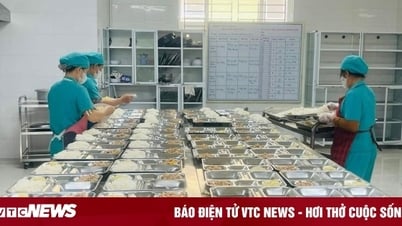On April 2, US President Donald Trump issued an Executive Order on reciprocal taxes applicable to goods imported into the country.
Regarding this content, Mr. Ta Hoang Linh - Director of the Department of Foreign Market Development - Ministry of Industry and Trade shared with the press the views of the Vietnamese Ministry of Industry and Trade on this incident.
- The US has just imposed a tax rate of up to 46% on Vietnamese exports to this market. What are the specific assessments of the Ministry of Industry and Trade after this tax order?
The Ministry of Industry and Trade regrets that the US has announced a 46% tax on all Vietnamese exports, effective from April 9.
Vietnam and the US are two complementary economies , the export and foreign trade structures of the two countries do not compete directly but complement each other, in accordance with the internal needs of each country. Vietnamese goods exported to the US mainly compete with third countries, not directly with American enterprises in the US market. On the contrary, Vietnamese goods exported to the US also create conditions for American consumers to use cheap goods.

Mr. Ta Hoang Linh.
The average MFN tariff that Vietnam currently imposes on imported goods is 9.4%. Therefore, the reciprocal tariff that the US plans to impose on Vietnamese goods of up to 46% is unscientific and truly unfair, and does not reflect Vietnam's goodwill and efforts over the past time in dealing with the trade deficit between the two countries.
In recent times, the Government and ministries have resolved a series of difficulties and obstacles for US businesses in Vietnam, issuing a Decree to reduce MFN tariffs, in which 13 groups of advantageous US goods benefited. In addition, many US projects in Vietnam have received attention, resolved and removed difficulties and obstacles.
According to the White House announcement, the reciprocal tariffs that the US imposes on its trading partners aim to correct global trade injustices, bring manufacturing back to the country, strengthen national security, and promote economic growth.
It is understood that the tariffs will remain in place until the US determines that the threat posed by the trade deficit and unfairness in trade is addressed, remedied or mitigated.
Therefore, the Ministry of Industry and Trade believes that there is still room for discussion and negotiation between the two sides to reach a mutually beneficial result.
This morning, right after the US announced the imposition of tariffs, Minister of Industry and Trade Nguyen Hong Dien sent a diplomatic note requesting the US to postpone the decision to impose tariffs to take time to discuss and find a reasonable solution for both sides.
We are arranging a phone call between the two Ministers as well as at the technical level with our colleagues at the Office of the United States Trade Representative (USTR) as soon as possible.
- In your opinion, how will this decree affect Vietnam's export growth target in 2025? What solutions and recommendations does the Ministry of Industry and Trade have for businesses to ensure export growth targets?
In 2025, the Ministry of Industry and Trade aims for export growth of about 12%, equivalent to about 450 billion USD. This target is set in the context of global economic recovery and Vietnam taking advantage of signed free trade agreements.
In case Vietnam and the US cannot find a positive solution, this tax imposition will have a certain negative impact on the export growth target.

Mr. Trump announced the reciprocal tax rate on April 2.
However, this is also an issue that the Ministry of Industry and Trade has predicted and prepared for. The Ministry has also proposed a specific Action Plan to the Government and advised businesses to take necessary steps when the problem occurs.
The Ministry of Industry and Trade forecasts that in the coming time, our export activities will face many difficulties, therefore, close coordination between ministries, sectors and enterprises is needed to effectively implement the proposed solutions to achieve the export growth target in 2025.
To realize the above goal, the Ministry of Industry and Trade believes that export enterprises need to take advantage of existing strengths, which are 17 free trade agreements with over 60 countries and territories and 70 bilateral cooperation mechanisms.
At the same time, businesses also need to promote the diversification of export markets. The US market accounts for 13% of global imports, but Vietnam's exports to the US account for 30% of Vietnam's total export turnover. This is an advantage but also a weakness of export activities. Vietnam still has many opportunities to exploit the remaining 87% of the world's market. The Ministry of Industry and Trade will continue to make efforts to open up export routes to new markets with much room.
In the coming time, the Ministry of Industry and Trade will continue to promote negotiations of FTAs with new markets in the Middle East, Latin America, Central Asia and other emerging markets.
In addition, trade promotion and logistics infrastructure improvement should be strengthened to reduce transportation costs and enhance the competitiveness of Vietnamese goods.
In addition, the Ministry of Industry and Trade also aims to expand the system of Vietnamese Trade Offices abroad to better support businesses in trade connection and export promotion.
In the long term, Vietnam will also have to restructure its economy, diversify markets, diversify products, and diversify supply chains to ensure rapid and sustainable development. Because a sustainable export industry cannot rely solely on processing, but must also rely on science, technology, and innovation to make the economy more resilient and minimize negative impacts from external shocks.
- What does the Ministry of Industry and Trade recommend domestic enterprises do to minimize risks from international trade fluctuations in the coming time, sir?
In the context of the US imposing reciprocal tariffs on global trading partners, to minimize risks from international trade fluctuations, the Ministry of Industry and Trade recommends domestic enterprises.
First of all, diversify export markets, effectively exploit key markets, traditional markets, as well as develop small markets, niche markets and open up new potential markets.
Second, improve product quality, ensure products meet technical, labor and environmental standards of export markets, to increase competitiveness and reduce the risk of being subject to trade defense measures.
Third, control the origin of raw materials: Focus on controlling the origin of raw materials for production, ensuring compliance with the rules of origin in the FTA and avoiding risks related to trade fraud.
Fourth, strengthening trade defense capacity. Enterprises raise awareness and ability to respond to foreign trade defense measures through updating information and participating in relevant training courses.
Fifth, proactively update market information, regularly monitor and update information on markets and trade policies of countries, to promptly adjust appropriate business strategies.
The synchronous implementation of the above solutions will help Vietnamese enterprises increase their resilience to fluctuations in international trade and maintain sustainable export growth.
Thank you!
Source: https://vtcnews.vn/bo-cong-thuong-my-ap-thue-hang-hoa-voi-viet-nam-len-den-46-la-khong-cong-bang-ar935604.html



![[Photo] Many young people patiently lined up under the hot sun to receive a special supplement from Nhan Dan Newspaper.](https://vphoto.vietnam.vn/thumb/1200x675/vietnam/resource/IMAGE/2025/5/18/6f19d322f9364f0ebb6fbfe9377842d3)



![[Photo] Ready for the top competitions of Vietnamese table tennis](https://vphoto.vietnam.vn/thumb/1200x675/vietnam/resource/IMAGE/2025/5/18/9c547c497c5a4ade8f98c8e7d44f5a41)




















![[Photo] General Secretary To Lam visits exhibition of achievements in private economic development](https://vphoto.vietnam.vn/thumb/1200x675/vietnam/resource/IMAGE/2025/5/18/1809dc545f214a86911fe2d2d0fde2e8)






























































Comment (0)